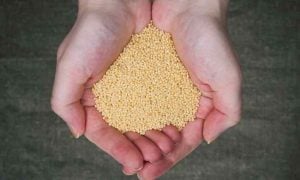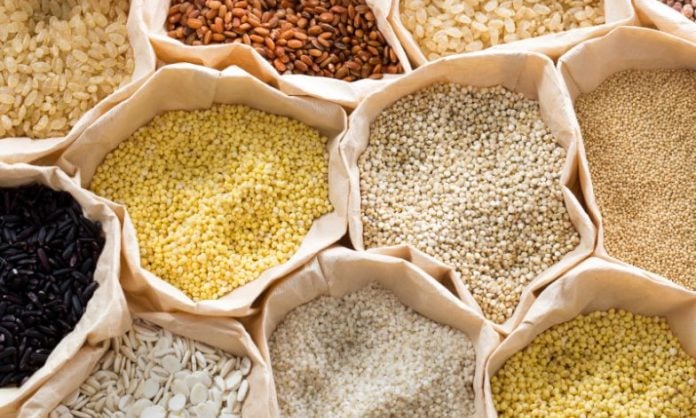Millets are resilient cereals that can provide an affordable and nutritious option and help guarantee food security. They are also deeply rooted in Indigenous Peoples’ culture and traditions. The United Nations General Assembly at its 75th session in March 2021 declared 2023 the International Year of Millets (IYM 2023) with the Food and Agriculture Organization of the United Nations (FAO) as the lead agency.
Why are millets a smart food?
Millets encompass a diverse group of cereals including pearl millet, proso millet, foxtail millet, barnyard, kodo, browntop, finger and Guinea millets, as well as fonio, sorghum (or great millet) and teff.
Millets can grow in both low and high altitudes and across a wide latitudinal range, on arid lands, under non-irrigated conditions, in very low rainfall regimes, and have a low water footprint. Millets require less water than rice and wheat. They are very tolerant of heat (up to 64 degrees Celsius), drought and flood and it makes the crop an obvious choice for farmers in an era of climate change and depleting natural resources.

Millets are an ideal solution for countries to increase self-sufficiency and reduce reliance on imported cereal grains. They need minimal inputs, are resistant to diseases and pests and offer a reduced dependence on synthetic fertilisers and pesticides. They are also more resilient to changes in climate than any other cereals. On top of diversifying the food system, millets can help enhance livelihoods for small farmers, including women, nationally and regionally.
Nutritional and health benefits of millet consumption
Millets are among the first plants to be domesticated and are considered “nutri-cereals” due to their high nutritional content. They are rich in vitamins and minerals, including iron and calcium; are high in protein, antioxidants, resistant starch, and have a low glycaemic index, which can help prevent or manage diabetes. Millets are also gluten-free. As whole grains, millets provide different amounts of fibre. Dietary fibre has a role in regulating bowel function, blood sugar and lipids, and satiation.
Millet production in the world
Millets have served as a traditional staple for hundreds of millions of people in Sub-Saharan Africa and Asia (particularly in India, China, and Nigeria) for 7000 years and are now cultivated across the world. Estimates show that more than 90 million people in Africa and Asia depend on millets in their diets.

Africa accounts for more than 55 percent of global millet production, followed by Asia with nearly 40 percent, while Europe represents around three percent of the world market. In recent years, their production has gradually declined due to market distortions, a lack of appreciation of the benefits of millets and policies that have favored the production of the so-called Big Three cereals – rice, wheat and maize. Farmers have switched to cultivate more remunerative crops grown to sell for profit. They moved away from subsistence agriculture responding to changing consumer preferences and markets inputs.
Millets in Europe
Millet cultivation began in Europe around 3,500 years ago. The oldest cereals come from the eastern part of Europe, including Ukraine, which is consistent with the concept of the arrival of domesticated grain from Asia. Thanks to millets’ wide range of growing conditions and a lifecycle shorter than three summer months, they offer an additional harvest and therefore surplus food and fodder. It was likely a transformative innovation in European prehistoric agriculture previously based mainly on (winter) cropping of wheat and barley.

Revitalisation of millets
As the cultivation of millets is declining in many countries, their potential to address climate change and food security is not being realised in full. With a deepening climate crisis and multiple environmental stresses, this recently forgotten and underutilised crop could be the crucial link in the sustainable food supply chain as well as one of the climate resilient solutions. Contributions of millets to nutrition, livelihoods and incomes of family farmers, especially small-scale family farmers, can play an important role in contributing to food security and eradicating poverty. The popularisation of millets is also an effort to achieve the Sustainable Development Goals (SDGs), and in particular: SDG 2 (zero hunger), SDG 3 (good health and well-being), SDG 12 (sustainable consumption and production), and SDG 13 (climate action).
The International Year of Millets 2023 will focus on:
- Raising awareness of the nutritional and health benefits of millets and promoting millets as a key component of the food basket.
- Raising awareness of the contribution of millets to food security and their important role in keeping a check on food wastage. Some of the millets are good for consumption even after 10-12 years of growing!
- Promoting the sustainable cultivation of millets, also under adverse and changing climatic conditions and improving their quality.
- Highlighting their potential to provide new sustainable market opportunities for producers and consumers. Greater millet production can support the livelihoods of smallholder farmers and can provide decent jobs for women and youth.
- Promoting a better utilization of crop rotations.
- Enhancing investment in research and development.
More information:
Millets prove tasty solution to climate and food security challenges
Millet seeds, a powerful weapon against hunger
International Year of Millets 2023 – Building momentum for the year
Sorghum and millets in human nutrition
2023 : Année internationale du mil, une céréale « durable »

